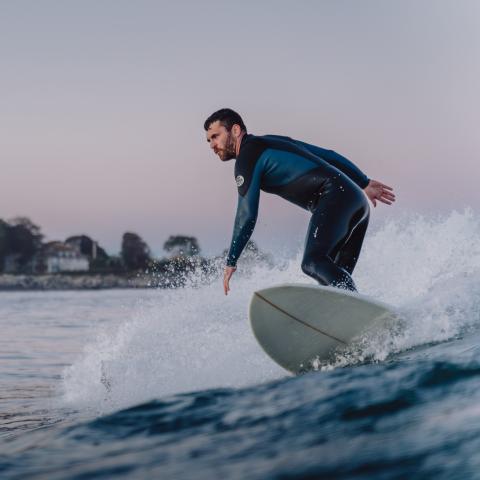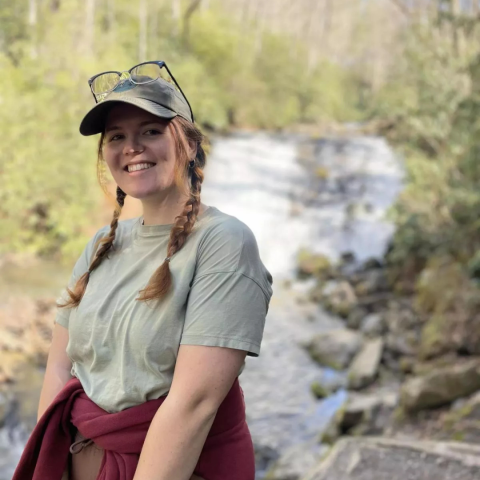What’s in the Foam? PFAS Takes a More Visual Form [Podcast]
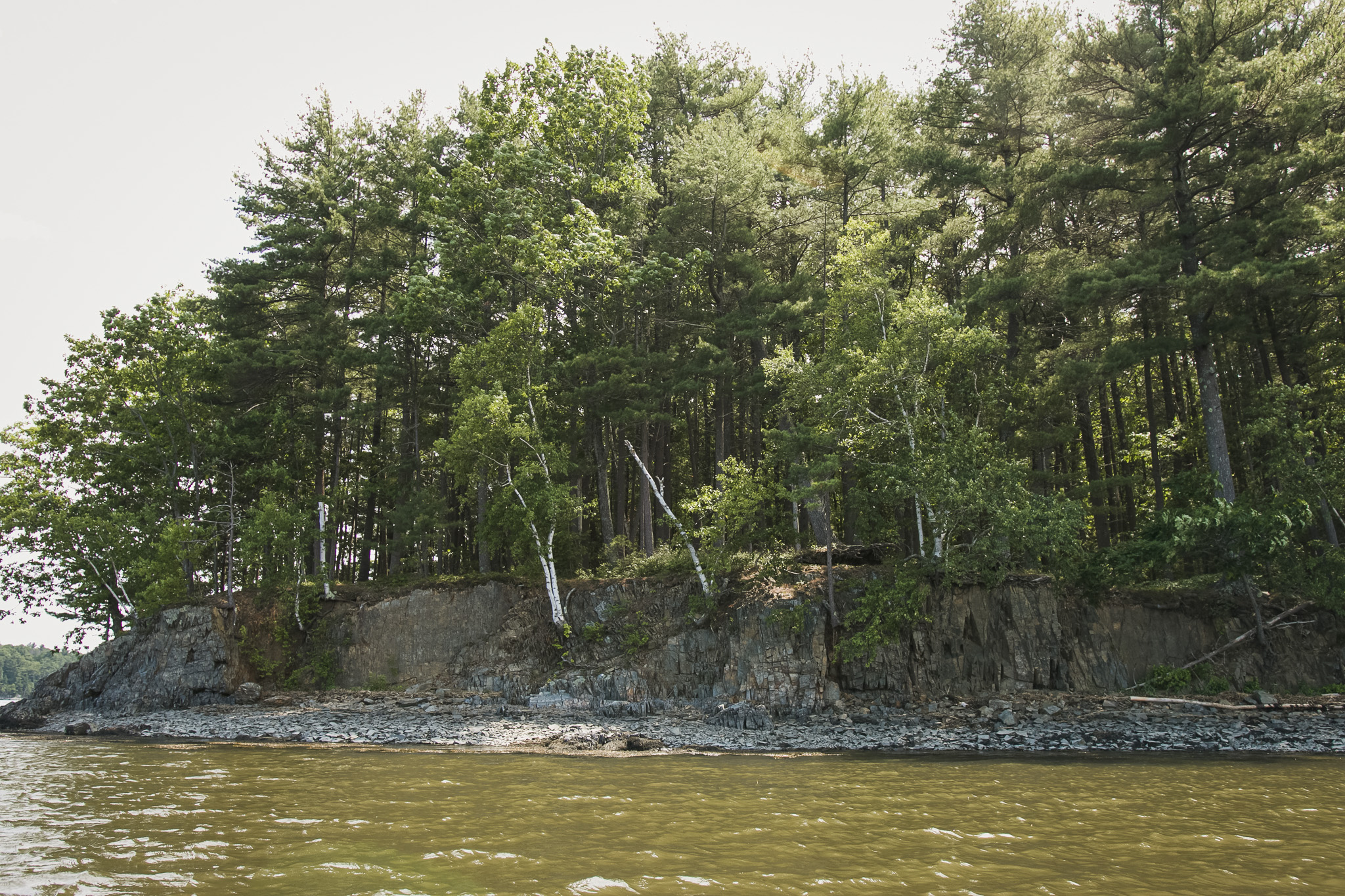
Show Notes
PFAS are contaminants of emerging concern and have rapidly become a focal point for everyone working in the field of clean water. These ‘forever chemicals’ are impactful in very small amounts (parts per trillion), have negative impacts on humans, and are present within a wide variety of consumer products.
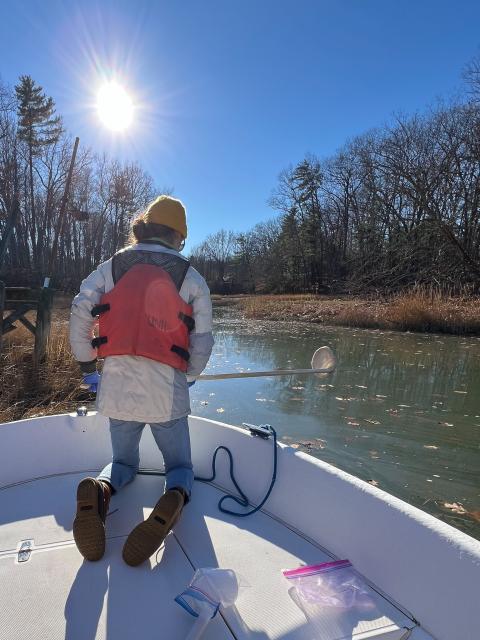
Gabby Deangelis kneels on the bow of a boat in Great Bay, with a skimmer to collect surface foam samples.
Because PFAS are odorless, tasteless, and microscopic, it is difficult for people to visualize this threat to human health. However, residents in New Hampshire have recently expressed concern that surface foams forming in known PFAS-contaminated water bodies may contain elevated levels of these ‘forever chemicals’. This prompted a team from University of New Hampshire, Temple University, and local citizens to join together in testing foam from these locations. Here, we discuss their preliminary findings, and what will come next.
Act 1: Dr. Paula Mouser describes the story behind exploring PFAS concentrations in surface foam at sites known for their PFAS exposure.
Act 2: Gabby Deangelis, a Master’s student at UNH, shares her personal experience being affected by PFAS, and her creativity in developing methods to sample surface foams. Gabby also shares her experiences as a graduate student working in the field of environmental science.
Act 3: Andrea Amico discusses her family’s exposure to PFAS, and how this sparked her journey to raise awareness and take action to address this contaminant in our waters. Andrea describes her work as a citizen scientist with Paula’s team while explaining the impact of including community members in research.
Full episode transcript available below.
Guest Speakers
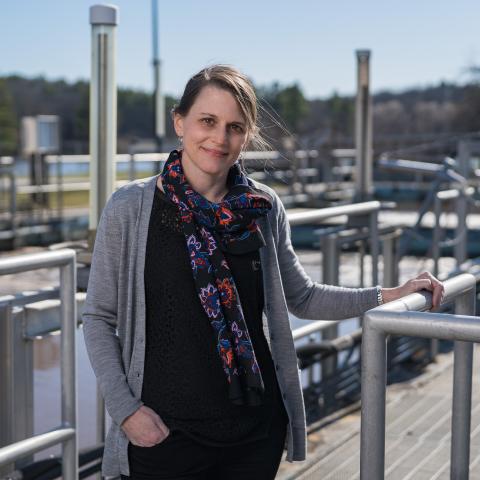
Paula Mouser, Ph.D.
Professor, Civil and Environmental Engineering, University of New Hampshire
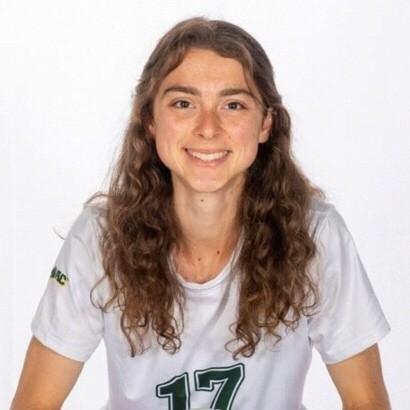
Gabby Deangelis
Graduate Student in Environmental Engineering, University of New Hampshire
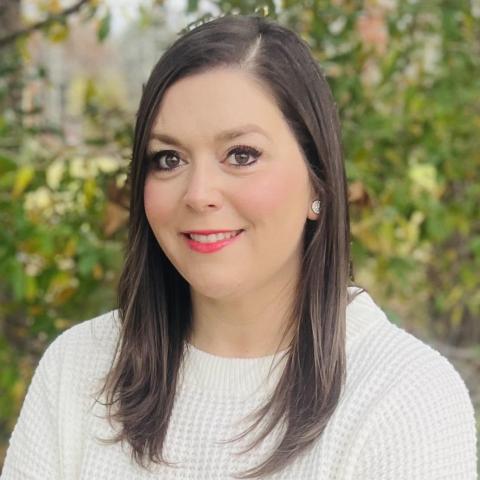
Andrea Amico
Clean Water Activist, Citizen Scientist, and Founder of Testing for Pease
Episode Transcript
Brian Yurasits: [00:00:00] So picture this, you're standing at the edge of a river. Maybe it's the oyster River, right here in New Hampshire. The water is moving slow, steady, but something else catches your eye. A cluster of foam collecting along the shoreline, swirling in the eddies. It looks harmless, like the kind of bubbles that you might see after a heavy rain, but hidden in that foam, in microscopic invisible ways is something far more concerning, PFAS.
Lauren George: Maybe you've heard of them. per- and polyfluoroalkyl substances, they're the chemicals that make rain jackets water resistant, keep food from sticking to pans and help firefighting foams put out flames. They're useful, ubiquitous, and nearly indestructible. Scientists call them forever chemicals because they don't really break down.
Instead, they travel through soil, through water, through air showing up in places they were never meant to be, including as it turns out, [00:01:00] in that unassuming river foam at your feet.
Brian Yurasits: This is where Dr. Paula Mouser comes in. She's a civil and environmental engineer at the University of New Hampshire, and she's been asking a simple but important question.
If PFAS are in our water, could they be concentrated in surface water foams? And if they are, what does that mean for the rivers and streams that we rely on? So to answer these questions, Dr. Mouser assembled a team, including colleagues from Temple University and two citizen scientists, people who weren't researchers by trade, but were curious and concerned enough to get involved with funding from New Hampshire Sea Grant and Piscataqua Region Estuary's Partnership, our region's National Estuary program based at University of New Hampshire.
This team set out to find answers.
Lauren George: And what they discovered was startling. PFAS levels in some foams were seven to 70 times higher than in the surrounding water,
Brian Yurasits: Which if you think about it, changes the way you see that foam, [00:02:00] the way you see the river, the way you see what's happening all around us, mostly unnoticed
Lauren George: Today on time and tide, we're diving beneath the surface of PFAS and into this study what it tells us about PFAS and our waterways, and the larger questions it raises. How do these chemicals get here? What risks do they pose and what, if anything, can we do about them? That's all coming up. Stay with us.
Brian Yurasits: You may also notice that we have a guest co-host with us today, Lauren George. Lauren is a marine biology graduate student assisting with science communications, and we're excited to have her along for the ride.
Thanks Paula for joining us on our podcast and sharing a deeper dive into this study that you worked on on PFAS in New Hampshire. And I'm wondering if you could tell, tell our listeners a little bit about [00:03:00] your experiences in this field and, and what motivated you to, uh, work in this field.
Paula Mouser: So I'm an environmental engineer and my research has focused on contaminants and water, and I've studied legacy contaminants, things like landfill, leachates that leach into groundwater, and more recently emerging contaminants. And I'm particularly interested in how microorganisms transform contaminants because it can change how the compound moves through natural environments and engineered systems.
So I became interested in PFAS about seven years ago because there was really a lot of, there was a gap in information about how they moved through our sewage facilities and microorganisms are responsible for a lot of the, um, degradation in sewage facilities. But they're not designed to treat these contaminants, and so we wanted to learn more about how these compounds are partially broken down during wastewater treatment.
Brian Yurasits: Where [00:04:00] generally are PFAS found in New Hampshire? I know you mentioned your work with wastewater treatment facilities, being a place that they might collect and, and we might be able to learn about them more, but where, where else have they been of concern?
Paula Mouser: Well, PFAS are present in a wide variety of industrial and commercial products, and they end up in our waste streams.
And so there are concern in, in all the discharges that we have, so that can be air stacks from industries that are using them for products. It can be in our water and wastewater in our discharges from those, uh, facilities, as well as in our sludges or biosolids. And fortunately, municipal wastewater treatments are the collectors and concentrators for a lot of these wastes, and so a lot of regulatory and public attention has been focused on the discharges from wastewater, which is part of the reason why I am so interested in them right now.
Lauren George: So can you tell us a little bit more about foam and surface water? I feel like if anyone has ever [00:05:00] been to a beach or like really any body of water, a river, ponds, you've seen foam in one form or another. Does it occur naturally? And if so, what is normally in it?
Paula Mouser: I think foam in surface water is a really fascinating phenomenon, and most of us have probably seen it at beaches or collecting along rocks and streams, right?
It's a natural phenomenon and it comes from the breakdown of organic materials like leaves or microorganisms such as algae. These biological materials contain compounds like lipids and proteins that tend to separate from water due to their chemical structure. And so if you have a situation where a lot of air is introduced to water, like the discharge below a dam, or if there's a lot of mixing along a shoreline, a tidal area, you can have foam, which is formed when these natural compounds separate into the air, it appears as foam on the surface water.
Lauren George: How would pollutants then cause foam to occur?
Paula Mouser: So [00:06:00] some pollutants are actually designed their chemical structure as a surfactant, and that means they're gonna interact with both water and air. Soaps are a great example of surfactant. When we have that, um, that dilute chemical and we mix it with water and air, it causes bubbles.
Well, many PFAS have surfactant like chemical structures. They have this water loving or hydrophilic head, which likes or prefers to be in the water. Then they have this water repellent or hydrophobic tail that contains the carbon and the fluorines, and it prefers to be away from the water. And so in this case, the contaminant might rise naturally to the top of a stream or a water body to try to interact more with that air phase.
So when mixing happens, um, it introduces air, causes the contaminant to rise out of the water and form these foam bubbles.
Brian Yurasits: Who, who was the first to in your world bring up foam, uh, as a, as a public [00:07:00] health concern to you. And where were they concerned about this foam occurring naturally?
Paula Mouser: I'm actually gonna back up a little bit because we've been thinking about foam and engineering for several years now.
There's an emerging remediation tech technology known as foam fractionation that's being tested on concentrated waste streams, like landfill leachate in order to try to remove the PFAS. And what happens is we blow air and surfactants into the waste stream and it causes a foam, which we collect, and then we can treat it separately. And naturally this led to thinking about foam in surface waters where we can see it and it's visible. So, uh, about a year ago, I, I was contacted by a citizen scientist, Andrea Amico, who was concerned about some of the foams that she had seen in the surface water bodies around Portsmouth and Newington. From her standpoint, um, she's concerned about whether or not they might be, they might be a health risk.
And from my standpoint, I'm just interested in what they might be, [00:08:00] um, comprised of. You can't tell just by looking at them because they don't have a smell. They're odorless and the characterization of the composition, um, requires molecular tools.
Brian Yurasits: So there's no real surefire way to tell if foam in a, in a given water body contains contaminants or is entirely natural.
Paula Mouser: That's true. Um, they do have different, um, visible shapes though. And some of the preliminary research that's come out of a study out of Michigan has documented what some of these foams look like and oftentimes if they're very fluffy and stiff, they might have a contaminant like PFAS in them.
Brian Yurasits: And I want to get into this word that you used preliminary. You have formed these questions and you reached out to New Hampshire Sea Grant for some, almost like seed funding. I'm curious if, if you could talk us through, like how did that process work for you?
Paula Mouser: Uh, there aren't a lot of opportunities in research to get a little bit of money for preliminary studies, and so New [00:09:00] Hampshire Sea Grant's development Fund is such a great place to send these seed ideas.
Brian Yurasits: It seemed like a very, a very small initial project that kind of reached a lot of different players and people.
Paula Mouser: We thought it was important not just to characterize PFAS in the foams, but also, um, the microbial community and the nutrient composition. So we formed a team that included others who could help us look at that molecular characterization.
We included Ashley Bulseco, who's a, who's a new professor in biology here at the University of New Hampshire, who's looking at the microbial community composition Gangadhar Andaluri at Temple University, who's responsible for characterizing the PFAS, as well as Andrea Amico and uh, Dr. Rosalie Lopresto, who's another citizen scientist.
I should also emphasize that in research studies that have potential health implications it's critical that we develop trusted partnerships with community members that are built on [00:10:00] transparency.
Brian Yurasits: If you could speak to the goals of this preliminary study, so, and just get into like a little bit of what a preliminary study, what it can be and what it can't tell us.
Paula Mouser: We had a couple of of goals. The first was that we wanted to test out some methods for collecting foam samples, and so we started off by designing a sampler that allowed us to skim the foam off the top and try to sample from the top section of the surface water. And we only budgeted 16 samples. And with that kind of a sample budget, you're not able to get an exhaustive study completed.
And so really it's just to help us characterize the initial composition, form some initial hypotheses that allows us to identify future areas for sampling, build collaborations for a larger study, and identify zones to go out and do additional sampling. The preliminary study has helped us bring awareness on the topic to the community and state.
So for [00:11:00] example, um, the New Hampshire Department of Environmental Services has already released a fact sheet on the foam that provides some information about the possible health risks.
Lauren George: What made you choose exactly where to sample? Were there any like preliminary, um, qualifications?
Paula Mouser: So foam is ephemeral, which means it's not always there, and so there's a risk that you could go out for sampling if you don't know where it is and you won't see anything.
We started by identifying areas with known PFAS contamination. Where we would have the highest likelihood of potentially seeing foam and, and we looked across some areas where we thought there would be high concentrations to low concentrations so we could see some sort of gradient. We also worked closely with the citizen scientists who were out walking along these tributaries that are publicly accessible, and when they would see foams.
They would call us and we could gather our sampling team and our, our sampling equipment, and we went out and we would collect samples with them. So we really had kind of boots on the ground. [00:12:00] We went out with New Hampshire Sea Grant boats and, um, and, and ended up finding them where we suspected that they would be.
Brian Yurasits: What would be the levels that would impact public health? Is there more information that needs to be collected to, to really understand the impact on public health?
Paula Mouser: PFAS is regulated in New Hampshire in drinking water, and in that case you're ingesting it in, in large amounts. And so the regulatory levels are fairly low.
They're in the low part per trillion. In surface waters we're not generally drinking that water. We might be interacting with it in a different way. We, uh, we observed PFAS in the foams, um, on the order of hundreds to thousands of parts per trillion, okay? And they were concentrated in the foam relative to the surface water that was right below it.
Brian Yurasits: The surface foams visualize, uh, this invisible contaminant, right. And I think that is what makes people so interested in [00:13:00] it and, and concerned about it. What would you say to folks who might see foam or be concerned about it for their own health as they're kayaking or recreating on our coasts this summer.
Paula Mouser: I think there are some areas with legacy PFAS contamination where foam is uh, occurring regularly, where signage could be really important for deterring people and animals to interact with that foam. But as we talked about earlier in the podcast, this foam forms naturally. And so if you're kayaking in pristine areas in New Hampshire and you see foam forming along branches and along rocks, that doesn't mean it's going to be a contaminant there.
And so I think the best advice is to use common sense. If you see something that looks a little out of the ordinary in an area that we know maybe has legacy contaminants, then, then, um, I would recommend avoiding it.
Lauren George: So, Paula. As we've been talking about, this is a preliminary study, um, what are your future plans for this PFAS research in [00:14:00] foam?
Paula Mouser: We weren't able to find a lot of published information about PFAS and foams.
There's been a study released by the state of Michigan, but not a lot of peer reviewed literature, and we're really looking forward to trying to pull together some of our preliminary data as we collect more samples to try to put this information out there so that we can, as a scientific community, learn more about where, when, and what these foams are all about.
And one of the things that we've been talking about is the development of kind of an observation database. Um, since we started this research, I've been getting emails and calls about from the public, um, who've observed foam in different areas. And so I'd really like to better understand where people are seeing the foams.
Brian Yurasits: Thank you so much, Paula, for sharing your insights on this very interesting issue that a lot of people are concerned about.
Paula Mouser: Thank you so much, Brian and Lauren. It was a pleasure to speak with you both.[00:15:00]
Brian Yurasits: Gabby Deangelis is currently pursuing a master's degree in environmental engineering at University of New Hampshire. We'll hear from her next about her role in designing protocols for this study, what drew her into the field of PFAS research, and what advice she has for students deciding whether or not to pursue grad school.
Don't drift away. We'll be right back.
Gabby Deangelis: I am Gabby Deangelis, and I am currently in the first year of my Master's of Environmental Engineering.
Brian Yurasits: How did you get connected with Dr. Mouser and I'm curious how you came to be involved in this project on, on PFAS in surface water foam?
Gabby Deangelis: I have a previous experience with PFAS, I guess you could say.
Um, coming from Southern New Hampshire, I was affected by the [00:16:00] Saint-Gobain contamination in the beginning of high school, so it must've been like at least eight years ago. So we had water deliveries weekly in gallons and bottled water 'cause our well had to be capped from PFAS contamination. So it was felt really strange to not be able to just go to my tap water and like turn on the faucet.
'cause me and my brother grew up like playing around in our backyard, drinking the hose water all the time and stuff, so there was some great memories. Um, but then like kind of all of a sudden they're like, oh, you can't do that anymore. When I was applying for grad school, I saw that Dr. Mouser had a lab that was very involved with PFAS, um, research, and I thought that would be a great connection to have with my future career.
So I wanted to see if I could join.
Brian Yurasits: I'm curious if you could talk a little bit for anyone who's listening who's heard the word PFAS and is wondering what this mess of letters means?
Gabby Deangelis: Yeah, of course. Um, PFAS stands for per- and polyfluoroalkyl substances. I believe I'm pronouncing that [00:17:00] correctly.
Well done. Thank you. Um, and so it's essentially a class of molecules. There's a whole bunch of different compounds that are considered PFAS. Some of the higher known ones, I guess would be PFOA or PFOS. So PFAS and PFOS. But like, it sounds the same, but they are different. Like PFAS is the, is like the family of compounds.
And then PFOS is a specific one.
Brian Yurasits: I'm, I'm very glad that you took a stab at pronouncing that because. I wasn't going to be able to.
Gabby Deangelis: Okay, yeah.
Lauren George: Where could people find PFAS or PFOS in their everyday life?
Gabby Deangelis: The most common is in non-stick cookware. That's a big one. Mm-hmm. Uh, some rain repellent gear and like outdoor gear for hiking and things.
Brian Yurasits: I've heard, like paint, I've heard, um, like a lot of other, just everyday items.
Gabby Deangelis: The reason why they're so prevalent is because, um, they essentially don't degrade naturally at all. And that's, it's a double-edged sword because they're used because of their chemistry, but they're [00:18:00] also so deadly because of their chemistry and they don't go away once we make them.
Yeah, and they're hard to detect in nature because they are in such tiny concentrations. And so the detect limits of a lot of the instruments that labs use to analyze the concentrations of these compounds don't necessarily go that low.
Lauren George: This foam that you were collecting around these discharge areas, could you walk us through how you collected it?
Kind of what a day of sampling looked like?
Gabby Deangelis: So mostly when we went to the Great Bay for samples we got on a boat, which is pretty cool. And we used our sampler, I guess we call it, it's basically modeled off of a pond, skimmer or a pool skimmer. We got the idea from a study from Michigan. Uh, they used kind of a modified pool skimmer where they took the net off of the, the head of the skimmer and replace it with cheesecloth.
However, I could not find one pool skimmer that was not made out of plastic 'cause that would cross contaminate our samples with plastic PFAS in it as well. So we kinda made our [00:19:00] own, which is fun. So I bought some wood stakes from the garden section of Home Depot. We had some, uh, ring clamps in our lab, that stainless steel, and we attached those. Um, with a wing nut and then wrapped cheesecloth around the clamp.
Brian Yurasits: Why cheesecloth and wait, what? What is cheesecloth?
Gabby Deangelis: Its purpose is for straining liquid out of a semi-solid thing. Like cheese.
Brian Yurasits: Like cheese, yeah. Yeah. Hence the name. Yeah.
Gabby Deangelis: So we thought that was, that'd be perfect to kind of drain the surface water while also holding the foam.
Brian Yurasits: You get out on the boat and you have your team on out on that boat with you. And I assume you were the one doing the skimming?
Gabby Deangelis: Yes, I was skimming.
Brian Yurasits: Nice. Are you wearing gloves? Like is there any other ways that you protected yourself as well? 'cause I know that, you know, this is a contaminant that we're working with.
Gabby Deangelis: Um, so yeah, we wore gloves and we also took samples, paired samples of the surface water that was essentially right under the foam where we were skimming off of so we could [00:20:00] compare the concentration of PFAS and the constitution of the water and foam.
Brian Yurasits: From what I understand, you brought, uh, some of the citizen scientists out with you all.
Yeah. If you could talk a little bit about like, what it was like having them on the boat with your research team?
Gabby Deangelis: Yeah. Having Andrea on the boat was really cool 'cause she was taking pictures and super stoked that it was actually happening. Uh, I know she's worked really hard on kind of rallying behind PFAS studies and getting it to be more in the public eye.
Brian Yurasits: Did that make you feel like you were having like this bigger, like the work that you were doing was, was bigger than just UNH and and your lab.
Gabby Deangelis: That's a great point. I think coming out of the classroom and applying what I've been learning is pretty great. Um, and sometimes you can get kind of lost in just performance based expectations.
Like you gotta perform on the tests, you gotta perform in homework, in lab, and then that's it. But you're doing that work in order to be successful and help other people. And so having that. Kind of come full circle for kinda the first time for [00:21:00] me. It was is pretty cool.
Brian Yurasits: I feel like this is maybe a question for you both.
How did you decide that you were gonna pursue a master's degree studying this? This is a question that I, I hear across the board from students like, should I go and pursue a master's degree. Should I go and pursue a PhD in the field of environmental science?
Gabby Deangelis: Like, classic question, what do you wanna be when you grow up?
Like, I still don't really know. I'm still
Brian Yurasits: Neither do I.
Gabby Deangelis: Yeah, I'm still figuring that out. Um, but I think going to get more schooling I think is great if you have resources to do that. So I'm, I feel very, very fortunate to be at UNH and studying this and kind of seeing where research can take me. I didn't want to get a PhD 'cause I didn't necessarily see myself being a professor or doing research long term.
Brian Yurasits: Do you now?
Gabby Deangelis: I don't know. I would say I was, I'm more on the fence now than I was when I applied.
Brian Yurasits: So you're open to kind of anything you like wherever, wherever the world takes you, take that, take that path, I guess.
Gabby Deangelis: Yeah. I don't wanna close any doors. Like I'm opening, see what happens. Exactly.
Brian Yurasits: And what about you Lauren?
I'm, I'm [00:22:00] curious as well, it's very cool to have you like on this podcast helping me with science communications, but you similarly are in a master's program and I think this is just a really cool opportunity to talk about the differences between both of your paths and like where do you see yourself longer term as well and answering that question.
Like to PhD or not to PhD, right.
Lauren George: I wanted to do a master's to get more training, more hands on. Furthering my education was the idea that my research could have a bigger impact. My research is focused on an aspect of climate change and aquaculture, and I'm really interested in, you said earlier, Brian, getting out from behind the books and having applied research that could make a difference in communities.
To the question of a PhD, I think my research has opened a lot more doors, but is also a lot more questions as well with what I wanna do with my future. But that's not a bad thing. I think if you're an undergraduate student or even a high school student listening, I think it's great to look at those questions and see, [00:23:00] okay, do I like this?
What am I passionate about with my research? And to also be open to change and being like not set on a set path and being open to new opportunities that you didn't even know existed.
Brian Yurasits: Are you both in your first year or second year of Master's programs?
Lauren George: First year.
Gabby Deangelis: First year as well, that's another thing. This project moved super fast. Like I came here in the fall, first semester. Dr. Mouser had a plan, had a team together. I was in charge of getting together the sample, the sampling materials and the sampler and like the procedures. And then we got out within, or got out on the boat within like a month of getting funded, which was super cool.
And then now I'm on a podcast like, whoa, that's pretty cool.
Lauren George: Um, how does that make you feel being on the forefront of such new like, studies and like information?
Gabby Deangelis: I still like, have a little bit of, um, like imposter syndrome, but I feel like, I don't know, I guess that's natural, but I have so much to learn still.
And that's. Pretty awesome.
Lauren George: Um, I think I can [00:24:00] relate to that as a fellow master's student. Like you said earlier, the imposter syndrome is so real. Yeah. You graduate from undergrad and you're like, I did this great, amazing thing. I have my diploma. You walk in on your first day of your master's program and you're like, wow, there's so much more that I don't know.
Um, so I definitely understand that. But it is really cool to have that tangible, like preliminary result and be like, I was a part of this. I did this so, no, you're doing great. But I do understand it's a very common sentiment among grad students, whether you're getting your master's or PhD or even your postdoc.
Brian Yurasits: I also just wanted to say, Gabby, thanks for taking the time and coming out here and talking with us on this podcast. Add the podcast to your, to your list of grad school accomplishments. Check that one off on LinkedIn.
Gabby Deangelis: Yeah, thanks for having me.
Brian Yurasits: Up next, we speak with Andrea Amico, an advocate at the federal, state, and local level for clean water and action addressing PFAS pollution. Andrea brings the community perspective to the [00:25:00] table through her personal story and her participation in Dr. Mouser's study.
Andrea Amico: My name's Andrea Amico. I live in Portsmouth, New Hampshire, and in 2014, my life changed forever. I read a newspaper article that high levels of PFAS were detected in the drinking water at the Pease Tradeport. And uh, that was alarming to me because at the time my husband was working for a company there and my two small children were attending daycare there every day.
And so, um, I had never heard of PFAS before. I had no idea what they were, but, um, knowing that it contaminated drinking water at the Tradeport and they had to shut a well down. Was enough for me to be concerned and wanna ask more questions, and so really, oh, about 11 years ago now, I did just that. I started asking questions, I showed up to meetings and really educated myself about these chemicals and what they mean, and quickly learned that they accumulate in the body. They're associated with multiple adverse [00:26:00] health effects and so have been advocating on multiple fronts since then. One concern that I've had regarding PFAS contamination is with foam.
Um, I've learned from other communities across the country who I have been able to connect with over the last 10 years who are also dealing with the same type of contamination as us here, that in areas where there is high levels of PFAS, you can get this foam that accumulates on the waterways or on the shore.
And we certainly have a lot of waterways in this area. We certainly have multiple sources of PFAS contamination, and so in 2020 I started like looking out for it. PFAS testing in general is a bit difficult to obtain. Certain lab, only certain labs can do it. It's very expensive. Um, so it's not something I could just go out and coordinate on my own or pay for on my own.
And so I tried to explore some other options, uh, that didn't end up panning out. And last summer I decided to give Paula a call. I had met Paula a couple times. Uh, she had shared some of her work about PFAS and Great Bay not related to the Air Force, uh, a few years ago. And then she also came to Newington last year [00:27:00] and gave a presentation about PFAS and Great Bay.
So I knew that her and her students had been studying PFAS and particularly PFAS and Great Bay.
Brian Yurasits: What fascinates me about your story is that, you've been at this for 11 years before we hopped on this call, I was thinking of, I'm, I'm a big Lord of the Rings fan. Um, and I think of the hero's journey in a way of like storytelling.
And I, I hear your story and I think of your initial finding out that your children were exposed, possibly exposed to PFAS, right? Like, was, would you say that that was your like, call to, to adventure, a call to action, to be in, engaged in this issue and, and go on this 11 year long journey?
Andrea Amico: Yes. Absolutely. I mean, uh, by, by training i'm an occupational therapist. I work in healthcare. I'm not a scientist, i'm not an engineer. And, and as I said, I never gave a second thought to water quality or contaminants in water, just something, it was, something I was not familiar with, and it wasn't until my family was directly exposed and the lack of answers at that [00:28:00] time, um, that I just, it sparked a fire inside of me and I said, okay, I have to do something about this. I have to get more answers. It's just not okay that this happened to my family, especially my children. Here I am 11 years later and I honestly don't see this work really ever ending. You know, PFAS is such a big issue on so many fronts.
I think they'll. Always be things to be advocating for and continuing to push for. And I have told myself to pace myself. This work is a marathon and not a sprint, and I envision myself working on PFAS in some capacity forever.
Brian Yurasits: I've found that it's really the issues that affect human health that really do seem to resonate more broadly than anything else, and, it gets, it gets folks engaged at the state, their local. Mm-hmm. Even like the federal level.
Andrea Amico: Really just developing key relationships with people has been critical in advancing this issue. I would say the most effective relationships that I've had is at the federal level with our congressional delegation, [00:29:00] so, uh, Senator Shaheen, Senator Hassan, Congressman Pappas, um, they've been all instrumental in really helping to push at the federal level. I've been able to be part of a coalition of other advocates just like me, all across the country dealing with this issue. You know, it's not unique to just us. Um, some of my work at the state level has been pushing New Hampshire to set regulations for PFAS.
They did that before the EPA did. And then at our local level, you know, working with our city council, one thing I've really, i've done that I've been really proud of is I helped establish a safe water advisory group in the city of Portsmouth. So our city council approved that in 2020. I am, I'm just really proud of how communities can come together, develop key relationships, and then see positive change.
Brian Yurasits: Relationships are at the center, even even of how you got connected to, uh, New Hampshire Sea Grant and UNH as a whole. We support science, the science, right. But the science needs to be driven by the needs of the [00:30:00] community here.
Lauren George: As you said, you're not a scientist by trade. Mm-hmm. Could you tell us, kind of paint us a picture of what it was like to work with Paula and her team and kind of get into the research on that?
Andrea Amico: My experience with UNH has been incredibly positive. So first of all, I was very grateful that Paula had come out to the Newington community a year ago and shared her work in Great Bay and was very approachable and answered questions and really seemed to care about the issue. I reached out to her last summer and she was very responsive.
She got back to me right away. I shared pictures with her of the foam that I have, uh, had observed. I shared information about other states and what they had tested, and she was familiar with the foam and immediately was like, let's get a plan in place. You know, let's put a proposal together, let's apply for funding, I have a student who's interested. As a community, you know, member she included me in the proposal. I was allowed to make edits and suggestions, so it wasn't just me bringing the idea to her and she ran with it. Like I, I have felt like a part of the team the [00:31:00] whole time and my input has mattered and my collaboration has been appreciated, and I just can't be more grateful for that because sometimes as community members, when we engage with scientists, you know, we're not always respected or we're not always seen as a key stakeholder.
Brian Yurasits: Science is non advocacy, right? It's, it's mm-hmm. Figuring out how our world is changing due to humans, right?
Mm-hmm. And, and someone like you and Rose can take that information and help pull this, pull this information out into the public eye, into mm-hmm. Uh, share it with our decision makers. Like you, you naturally are that bridge. You got to get to go out there with, um, with Steve as well, right, who drove boat.
Did you have any fun experiences out on the boat with them?
Andrea Amico: It was a beautiful November afternoon, but it was chilly and windy and I appreciated it so much. First of all, just to see Great Bay from that perspective was incredible. So I didn't physically do the sampling, but I was there on the boat and I took [00:32:00] pictures, so I was like the picture taker of the process.
And then I also dropped the latitude and longitude points. I also helped beforehand with suggesting where we should sample.
Brian Yurasits: I know that, uh, public safety is one of, you know, we've spoken about that. It seems to be front of, front of mind for you. What are your public safety goals that, that might stem from the findings that, that you all were able to uncover during this study?
Andrea Amico: Public safety for sure, but just even public awareness. Because again, how many people recreate on Great Bay and fish there and boat and swim, wanting people to be aware that if there is foam, it could contain high levels of PFAS and to avoid coming into contact with it. Don't let your kids play in it. Don't let your dogs come into contact with it, your pets, things like that. And if you do come into contact with it, like go wash your hands. One thing I had noticed in other states that were doing testing on foam was they were issuing fact sheets and they were putting up signage to warn people and inform them about the foam and the PFAS.
And that's really [00:33:00] what I wanted to see in New Hampshire. One of the things that came out of this project was New Hampshire DES did issue a fact sheet on PFAS and foam and surface waters, and it is very consistent and in line with other states, and that ultimately has been my goal all along.
Brian Yurasits: Are you gonna keep the momentum rolling? And, um, you know, you've been at this for 11 years, so what is your, your plan for the next year, five years look like, kind of moving forward
Andrea Amico: As a result of this project, as you said, it was more preliminary data, it was just, you know, a handful of samples, but you have to start somewhere, right. And so because we now have this data confirming that PFAS do accumulate at much higher levels in the foam, um, that has prompted Paula to create a team to collaborate, to apply for even a bigger proposal, to do more expansive testing. And so my plan is to be part of that proposal with Paula and to continue the work on more expansive foam testing.
Uh, I want to do more efforts on my part to get the fact sheet out to the community, make sure people are aware of it, especially as we're moving into the warmer months. Lots to [00:34:00] come for sure, but uh, having more science on foam will be helpful. And you know, we are only a handful of states that have tested for foam.
So hoping that our work will also allow other states to feel empowered to do their own testing as well and issue their fact sheets and, and share information.
Lauren George: What would you say to people in New Hampshire or the broader New England community who may be interested and maybe concerned about this issue?
Would you give them like, a sort of call to action, what would you say to them?
Andrea Amico: In my area of work with PFAS, it didn't take like hundreds of us to come together. It took myself and a couple other moms to really just start asking questions, going to meetings. I don't have all the answers, I still don't. I had to educate myself. You know, don't be afraid.
It's a complex topic. But you can educate yourself. There's other people out there you can partner with. Show up, ask questions, care about the issue, stay persistent, pace yourself 'cause it's a long haul, and, um, you can make a difference. You know? Uh, figure out what your concern is, what your ask is, [00:35:00] and find the key people that are gonna help you reach those goals.
It's such a healing thing to be with a coalition of people. You know, this is such a devastating issue, really. I mean, people being exposed to toxic chemicals is awful, right? Um, but when you can partner with other people who are dealing with the same thing as you and are working towards positive change, um, that can be really healing and it can be really empowering.
Brian Yurasits: Andrea, I just wanted to say thanks so much for sharing your, your journey. You know, it, it is inspirational for other people to hear that, uh, that if you experience something like this in your life, that you can, uh, get involved and take action into, you know, take matters into your own hands and make a real tangible difference.
So, um, I just wanted to say thanks for sharing your story and, taking the time and keeping up this awesome work. 'cause I know you've been doing this for a long time and I imagine it's, it's a part of you now and
Andrea Amico: Yes,
Brian Yurasits: it's, it's not stopping anytime, [00:36:00] nothing's stopping you anytime soon, so.
Andrea Amico: Yeah. Yes, of course.
Well, thank you for inviting me to be here. And thank you to New Hampshire Sea Grant for funding this work. It's been really helpful and it, it's making a difference already.
Brian Yurasits: So, Lauren, thanks for going onto this foray into PFAS and foam. There are really two big takeaways that I came out with from this is, is one being that research that is designed with the community members in mind and, and hearing their perspectives and being transparent, uh, by involving them in the process, uh, that that can be really impactful. And the second big thing being that PFAS, it is an emerging contaminant that we don't know a lot about.
Lauren George: It's been a great learning experience and I've learned a lot about PFAS and citizen science, which I think is so, so important to remember as someone who is training to be a scientist and a researcher, but also going [00:37:00] back to the second point, this is a preliminary study.
There is still so, so much we don't know.
Brian Yurasits: You know, I'm gonna be very excited to see where their future work goes and what they're able to say, uh, about PFAS and foam moving forward and, and this visualization of a very invisible contaminant in our waters. Thanks for listening to Time and Tide, uh, and stay tuned for more episodes about the latest research happening on New Hampshire's coastline.
And Lauren, thank you again for being such a great co-host.
Lauren George: Thank you for having me.
Credits
Produced by Brian Yurasits, New Hampshire Sea Grant.
Cover photo by Brian Yurasits.
Transcribed by Descript. Edited by Brian Yurasits.
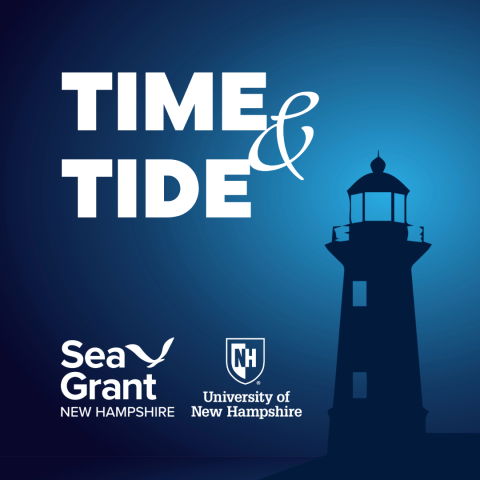
Time and Tide is a production of New Hampshire Sea Grant at the University of New Hampshire. Views expressed on this podcast are not necessarily those of the university, its trustees, or its volunteers.
New Hampshire Sea Grant works to enhance our relationship with the coastal environment to sustain healthy and resilient ecosystems, economies, and communities through integrated research, extension, education, and communications efforts. Based at the University of New Hampshire, New Hampshire Sea Grant is one of 34 programs in the National Oceanic and Atmospheric Administration’s National Sea Grant College Program, a state-federal partnership serving America’s coasts.
University of New Hampshire is an equal opportunity employer, learn more.
